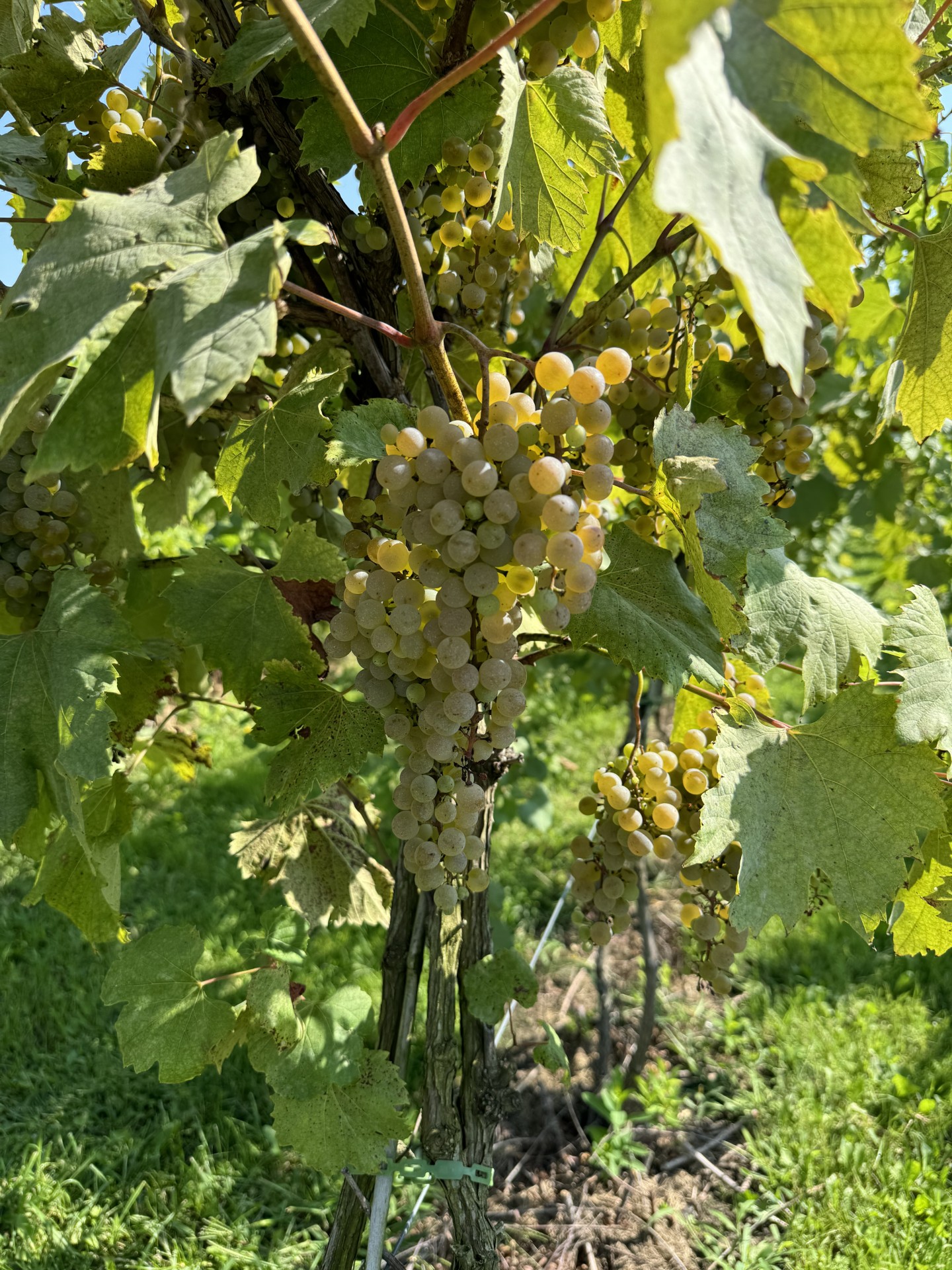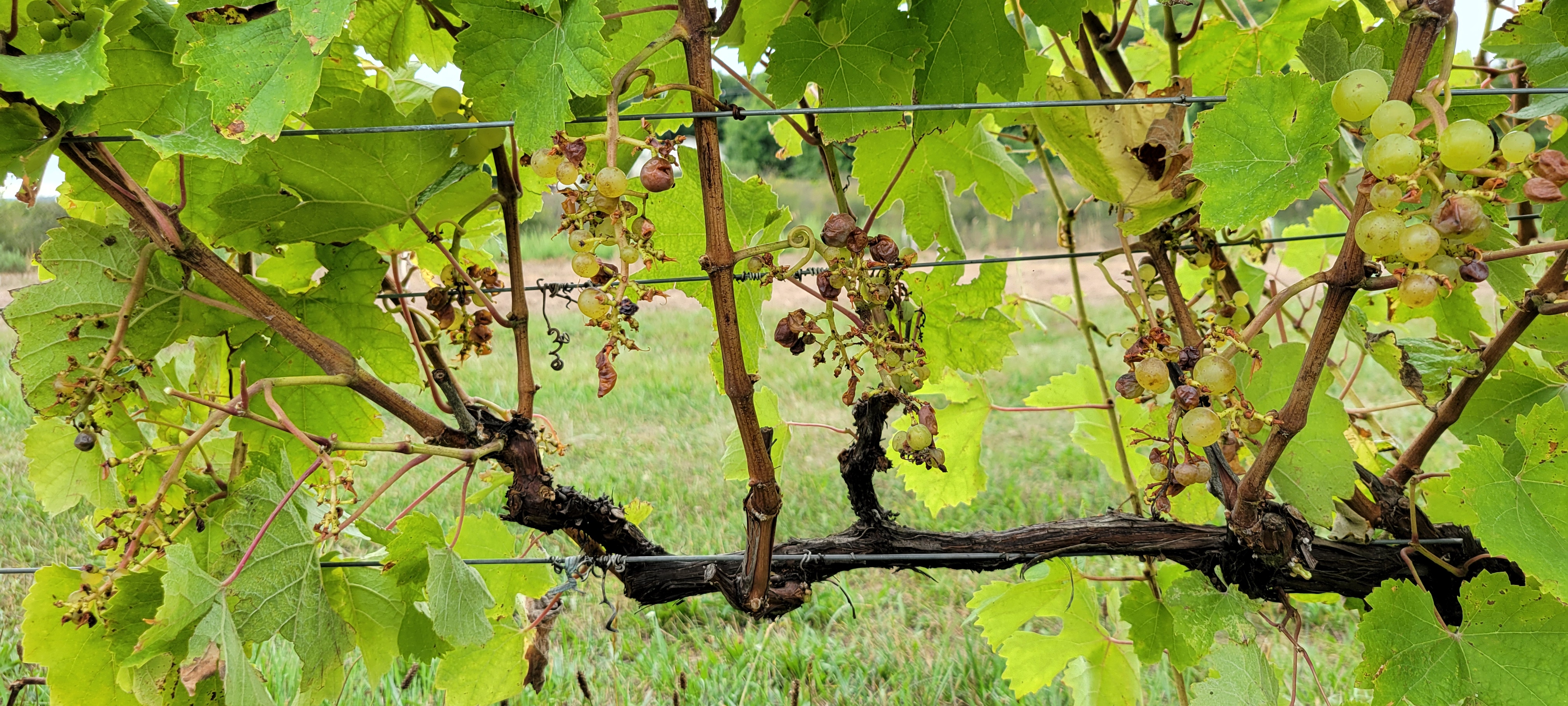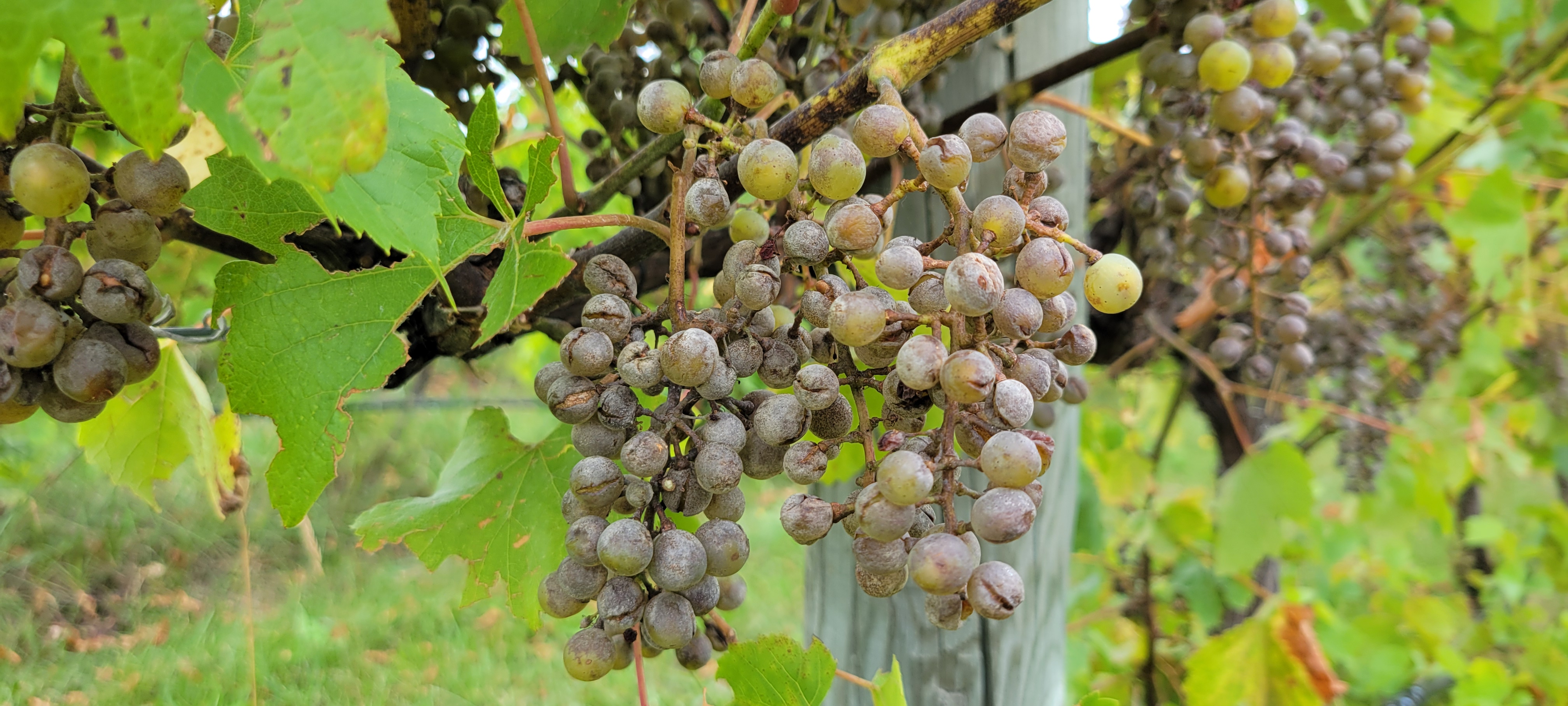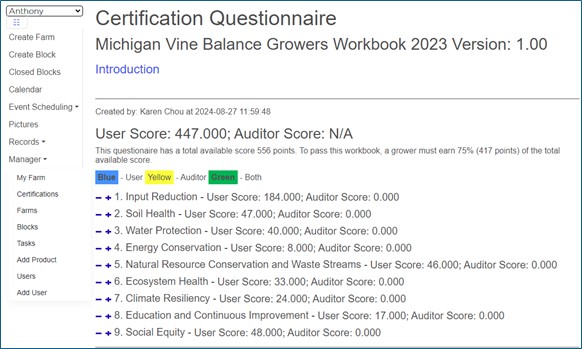Michigan grape scouting report – August 29, 2024
Stay informed and ahead of the curve with the latest vineyard updates and best practices in our comprehensive report. Enhance your grape growing success by leveraging expert insights on vine growth, disease management and innovative tools.

Weather
Click the following links for detailed seven-day forecasts for various grape production regions.
Southwest
Southeast
Northwest
See the latest agricultural weather outlook from Jeff Andresen, Michigan State University (MSU) state climatologist.
Check out the MSU Enviroweather Growing Degree Days (GDD) Michigan map. Find your closest weather station, create an account on the website, and track GDDs daily.
Report on growing degree days (GDD)
The following table summarizes the GDD base 50 degrees Fahrenheit for the current week and the previous week, as well as the accumulated GDD for each location.
|
Michigan grape growing region |
Current GDD 50 F Update 8/28/24 |
GDD 50 F last week 8/21/24 |
Collected the past week |
|---|---|---|---|
|
Benton Harbor (SWMREC) |
2522 |
2340 |
182 |
|
Fennville |
2292 |
2126 |
166 |
|
Lawton |
2483 |
2302 |
181 |
|
Average for southwest Michigan |
2432 |
2256 |
176 |
|
Romeo |
2350 |
2185 |
165 |
|
Average for southeast Michigan |
2350 |
2185 |
165 |
|
Old Mission |
1846 |
1699 |
147 |
|
Petoskey |
1826 |
1682 |
144 |
|
Traverse City (NWMHRS) |
2006 |
1841 |
165 |
|
Average for northwest Michigan |
1893 |
1741 |
152 |
Vine growth
Southwest Michigan
Harvest is underway. We are in the second week of harvest for early varieties in southwest Michigan. Several early hybrid varieties like Marquette, La Crescent, Frontenac and Petite Pearl are at or near 22 degrees Brix. Early vinifera like Sauvignon Blanc are near 19 Brix in some locations. Juice grapes are measuring above 12 Brix and harvest will likely begin early this year due to the warm season and very light crop. Niagara harvest should begin in mid-September.
Southeast Michigan
Growers continue harvesting seedless grape varieties, with Vanessa harvest wrapping up in Britton. Concord measured in Britton was at 13 Brix. Harvest started in Fredonia grapes in Romeo, Michigan, this week.

Harvest has started in some cold-hardy wine grapes, like Itasca. Itasca harvested at Youngblood Vineyards was at 24 Brix, pH of 3.09 and TA of 0.63 g/L as tartatic. Measurements done by Youngblood Vineyards Aug. 27 have Marquette at 21.7 Brix, pH of 3.1 and TA of 0.86 g/L as tartatic while Prairie Star was at 18 Brix. Some growers have put bird netting up in valuable varieties that have hit veraison. See more information about bird damage reduction strategies from Michigan State University Extension.

The next week will likely bring frequent light showers, which could make scheduling harvesting difficult. RimPro models for Romeo indicate a high risk of black rot conidia infection from Aug. 29-31. Downy mildew risk will be high for the entirety of the next week. Powdery mildew risk, on the other hand, will have low risk starting Sept. 1, with risk steadily increasing to near severe levels by Sept. 6.
Northern Michigan
In the vineyards of northern Michigan, grapes are in the veraison stage. The berries are softening and accumulating sugar, and they have reached approximately 80% of their final size. The clusters are in the bunch closure phase, a critical stage where the berries begin to tighten (E-L numbers 35-36).
Tip of the Mitt region
Hybrid cultivars continue through veraison with some nearing completion. Vinifera cultivars are proceeding through veraison. Powdery mildew and downy mildew have been noted in several vineyards. Growers have begun preventative measures to protect grapes from bird predation.
|
Variety |
Northwest region (Brix) |
Tip of the Mitt region (Brix) |
Southwest region (Brix) |
Southeast region (Brix) |
|---|---|---|---|---|
|
Riesling |
10.4 |
- |
- |
- |
|
Chardonnay |
13 |
- |
- |
- |
|
Pinot noir |
13.2 |
- |
- |
- |
|
Pinot Blanc |
13.2 |
- |
- |
- |
|
Pinot Gris |
13.6 |
- |
16.4 |
- |
|
Cabernet Franc |
9.5 |
- |
- |
- |
|
Marquette |
- |
16.2 |
22 |
21.7 |
|
Itasca |
- |
17.6 |
- |
24.0* |
|
Seyval |
- |
- |
18.8 |
- |
|
Prairie Star |
- |
- |
- |
|
|
Aromella |
- |
- |
16.5 |
- |
|
Concord |
- |
- |
- |
13 |
|
Niagara |
- |
- |
- |
- |
|
Chancellor |
- |
- |
- |
- |
*Harvested
Horticulture
Vineyard hedging has been going on for a couple weeks in southern Michigan and should begin soon in northern vineyards. The primary focus for hedging is on curtailing excessive primary and lateral shoot growth on the canopy's top and sides to prevent shading and entanglement between vine rows. By doing so, the vineyard becomes more accessible for workers and tractors. Interestingly, hedging also stimulates growth by promoting lateral shoot development in vigorous vines, despite the reduction of the canopy due to the removal of primary and lateral shoots.
It is recommended to perform hedging during the early to mid-summer period. Ideally, hedging is carried out between fruit set and veraison. This timing is crucial as it ensures adequate exposure of leaves, fruit, and developing buds to sufficient light, especially in dense canopies of hybrid cultivars with excessive vegetative growth. To avoid potential issues, it is essential to refrain from hedging too early in the growing season, as it may lead to increased lateral growth and canopy density.
However, we consistently perform early-season hedging due to late bud break and elevated spring temperatures, which promote vigorous growth early in the season. We always avoid hedging during bloom or shortly thereafter to prevent increased cluster fruit set that consequently increases cluster compactness, making the clusters more prone to harvest season cluster rot complex diseases. Growing grapes in Michigan can be likened to a "100-meter sprint," as Craig Cunningham, an experienced vineyard manager in Michigan, describes it, compared to the marathon-like growing season of other viticultural regions. Typically, we hedge twice: once before veraison, and once after. Hedging three times in a season is unusual and indicates a problem. If your vines require a third hedging, it likely points to issues such as inappropriate rootstock selection, excessive nitrogen levels, or incorrect planting density.
Cluster zone leaf removal is underway, depending on the region. Cluster zone leaf removal at the pre-veraison stage (mechanical or manual) is a critical viticultural practice with significant benefits for grape quality. By removing leaves around the grape clusters before veraison (the onset of ripening), growers can improve sunlight exposure and air circulation within the canopy. This increased exposure to sunlight enhances the development of desirable phenolic compounds and promotes even ripening, leading to better color, flavor, and aromatic profiles in the grapes. Improved air circulation reduces humidity around the clusters, which lowers the risk of fungal diseases such as powdery mildew and botrytis bunch rot, contributing to healthier fruit and reduced need for chemical treatments.
Diseases
During this time of the year, the primary diseases of concern for grape growers are phomopsis, black rot, anthracnose and powdery mildew. If you're seeking detailed insights into pre-bloom fungicide options and the effects of rain on disease spread, we recommend referring to a grape scouting report from earlier or exploring an article on early-season disease management. It's worth noting that some growers have recently observed isolated cases of downy mildew infections in northern vineyards. Southern vineyards have been seeing early infections of Phomopsis and are beginning to see black rot lesions on fruit and leaves. Powdery mildew symptoms are becoming more apparent, so vineyards should be scouted to check on the status of diseases.
With the exception of powdery mildew, these spring disease infections typically require rain events. It only takes 0.1 inches of rain above 50 degrees Fahrenheit to trigger a possible infection. Viticultural practices that reduce canopy wetness such as good irrigation timing, leaf removal and good weed management can reduce many of these diseases in a vineyard. Typically, DMIs (FRAC 3), captan and EBDCs (FRAC M3) are effective for Phomopsis, black rot and anthracnose.
Remember, as you choose a fungicide, check the Michigan Fruit Management Guide for potential phytotoxicity of certain sprays on Concord grapes especially (this has been particularly noted for fungicides like Revus Top). Phytotoxicity risk is higher with high temperatures and quickly growing vines. Also, there is a significant phytotoxicity risk with specific contact products such as copper and sulfur for Labrusca type grapes (Concord and Niagara).

It is important to remember to manage fungicide resistance and avoid applying similar products back-to-back. This is particularly important with site-specific systemic fungicides. To reduce the development of resistance with systemic fungicides:
- Do not make more than two applications per season of the same FRAC code.
- Do not make two consecutive applications of the same FRAC code.
- Rotate with unrelated fungicides in a different FRAC code that have efficacy on the target pathogen.
- Include a contact multisite fungicide into a program (e.g., sulfur, captan, oils or biological fungicides).
Since some parts of the state are near veraison, this is also an important time to consider botrytis management. Botrytis has been spotted in many early ripening varieties like Marquette, and sporulation can be seen on infected berries that were likely started by berry moth infestations. Several strategies contribute to good botrytis bunch rot management including opening up the canopy, effective insect control, properly applying fungicides and using resistant cultivars when possible.
Good botrytis control depends on getting good coverage. Just before bunch closure is the last chance to apply a fungicide to the inner part of the developing cluster. The most effective products for botrytis are site specific and prone to resistance development. A Michigan Grape Fact Sheet is available for managing botrytis bunch rot.
Insects
Control of insect pests has generally been good this season, except for a few hot spot locations where berry moth infestation is high. Even then the damage is mostly at vineyard borders, so treating at the border might be possible if your rows run the right way. With harvest starting in southwest Michigan table grapes, we are into the period where any spray decisions need to consider restricted entry intervals and preharvest intervals for timing harvest activity.
This time of year we also consider whether there will be a significant fourth generation of grape berry moth. This is expected to be moderate in 2024 because although the early timing of the third generation has “primed the pump” for a fourth generation, there are many factors also pushing back against it. Current populations of berry moth aren't very high, the weather this week has been extremely hot, and many vineyards will be harvested early. Scouting clusters this week in the Lawton, Michigan, area, we found many berries with damage but no larvae or with larvae that weren’t moving. At sites in southern Michigan with low grape berry moth pressure so far, additional treatment is unnecessary and won’t provide an economic return. At vineyards with significant infestation from the third generation, where harvest is still three or more weeks away, protection from grape berry moth is warranted to minimize a late-season surge from berry moth. Look for options with low enough preharvest intervals to avoid any problems with harvest timing.
Examination of our degree-day model for berry moth currently indicates that the southern Berrien County station at the Southwest Michigan Research and Extension Center with a May 16 biofix predicts an Aug. 31 start date for generation four egglaying. For Lawton with a May 20 biofix, the model predicts Sept. 3 or 4. For Fennville with a May 22 biofix, the model currently predicts well beyond the forecastable weather, so that timing would be further into September.
MSU is working with state and federal agencies monitoring sites across the state for spotted lanternfly, including multiple vineyard locations. Growers can help out by reporting any suspect detections to the Department of Natural Resource’s Eyes In The Field.
Participate in the 2024 VineBalance Pilot Program!
The Michigan Wine Collaborative (MWC) has launched the 2024 VineBalance Pilot Program, inviting Michigan grape growers to review and test the sustainability criteria used by the New York Sustainable Winegrowing certification program. To support Michigan grape growers in this effort and promote sustainable production, SAM Tool has integrated a web-based version of the New York Vine Balance scoring workbook for you to explore. We invite you to test the New York scoring criteria, assess their feasibility, and provide valuable input for developing the Michigan Vine Balance Workbook.
To participate in the Michigan pilot program and learn about the scoring method, please sign in to the SAM Tool and follow these steps:
- Sign in to your account.
- Create a farm (if you haven't already) by providing the farm’s address where you’d like to pilot the Workbook.
- Select the farm you created.
- On the left menu, click Manager > Certification.
- On the "Farm Certifications" page:
- Click the dropdown arrow under "Select the question set."
- Choose "Michigan Vine Balance Growers Workbook."
- Click "Start a new certification questionnaire."
- Then, click "Edit/View" for the new certification questionnaire you just created.
- Click the “- +” to view individual questions and assess your farm’s practices by selecting the boxes that best reflect your level of practice. The questions are divided into nine categories, with multiple sections within each category. See the screenshot below.

- As you answer more questions, the “User Score” at the top of the screen will increase. In the current New York Vine Balance program, farms that score 75% of the total score (417 points out of 556 in this version) and develop an action plan to address items with scores of 1 may be eligible for certification.
If you have any questions or suggestions, please feel free to contact Karen Chou at chouk@msu.edu or provide your comments through the “Issues” button on the SAM Tool website.
Upcoming events
The Great Lakes Expo: Dive deeper into grapes this year. The Great Lakes Expo, held annually in early December at the DeVos Place Convention Center in Grand Rapids, Michigan, is the largest show of its kind in the country. It attracts a diverse audience of grape growers from the Great Lakes region.
This year's Grape Section takes place on Tuesday, Dec. 10, 2024. We're offering the Grape Section in two sessions to provide a more in-depth exploration of both juice and wine grapes:
Morning Session: Focuses on all things juice grapes, covering topics like varieties, cultivation practices and juice production.
Afternoon Session: Delves into the world of wine grapes, exploring varietals and viticulture techniques.
This expanded format allows you to tailor your experience to your specific interests, whether you're a juice grape grower, a wine grape producer or simply curious about both. Don't miss this valuable opportunity to connect with industry experts, gain valuable knowledge and explore the latest advancements in the grape growing industry.
We look forward to seeing you there!
To get a better sense of the Great Lakes Fruit, Vegetable, and Farm Market Expo, check out this video.
Related articles
- Early season vineyard management
- Early season control of grape berry moth in Michigan vineyards for 2022
- Fruit insecticide registration update for 2023
- Michigan Grape Scouting Report for July 31, 2024
- MSU Fruit Pest Management Guide (E-154)
- Grape growth stages
- Early season vineyard disease management
- Early season vineyard management
- A Mobile Guide for Grape IPM Scouting in North Central and Eastern U.S.
- Using the MSU Enviroweather grape berry moth model in 2018



 Print
Print Email
Email